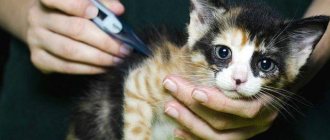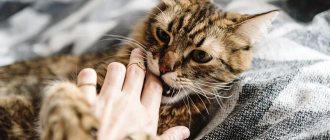Do cats eat hamsters?
The cat is an affectionate and kind creature, but the hunter's instinct remains throughout its life. A hamster running and playing will not leave her indifferent. But the character and upbringing of the cat are decisive.
Street cats are excellent hunters. This is their main way of subsistence. If you bring such an animal into your home, nothing good will come of it. Even if a cat has lived at home for a long time without going outside, nothing can stop the hunter’s instinct from waking up. If it suddenly happens that the cat ate the hamster, don’t scold him, you won’t go against your instincts.
Another type of cat is the mischievous one. Animals may not see the streets, but hunt for fun and pampering. The proximity of a hamster to such a cat is undesirable. If you leave animals together for a few minutes, irreparable things can happen. Cases of a cat eating a hamster are quite rare, but it can fatally injure it. If you notice that she is hunting a hamster, it is better to choose one. A furry friend will not be able to live in conditions of constant stress and will certainly get sick.
There are peace-loving cats, their hunting instinct is undeveloped, and the feeling of hunger is unfamiliar. These can be both domestically raised and street animals. In this case, they will easily get along with each other. They can play and even sleep together. Of the purebred representatives, these are Persian and British. By nature they are lazy and important. This is good, you don’t have to be afraid for such cohabitation.
Siamese and Abyssinian cats are aggressive, capricious, with a well-developed hunting instinct, and will not tolerate a stranger on their territory. If such a beauty lives at home, it is absolutely forbidden to get a hamster.
If you take a small kitten into a home that already has a rodent, they may be able to get along in the same area. The cat will show increased interest in him, watch, sniff, but will not cause harm. He will consider the rodent to be the owner of this place.
Things get worse if you bring a fluffy cat into a house where a cat lives. She may not accept the new neighbor, open the hunting season, try to eat the hamster or injure her with her powerful claws.
Different cats
The domestic cat belongs to the cat family, which has a highly developed hunting instinct. It is believed that cats rush at anything that moves. Is it really? It turns out that a lot depends on the character of the animal, place of birth, and upbringing.
Cats born on the street are always excellent hunters, because their existence depends on it. Hunting for rodents, in most cases, is their only food. If you pick up such a cat and bring it into your home, then be sure to expect trouble. When you see a hamster, the hunter's instinct will definitely awaken in him, even if the animal has lived in the apartment for several years.
There is another type of cat – the mischievous one. They hunt not for food, but for pleasure. It is characteristic that such a cat can be born, raised entirely at home and never experience hunger, and for her tracking a hamster is entertainment. In this case, the cat and the hamster are considered incompatible, and it is better not to leave them alone. It may happen that after strangling the hamster, she will bring it and put it at your feet. Don't punish her. The hunter's instinct tells him to bring the prey to the one whom the cat considers closest. If you hit, you may lose its trust forever, because the offended animal will not understand its guilt. When you see that a hamster and a cat in the same apartment are incompatible, make your choice in favor of one. A rodent may not be able to tolerate constant fear; stressful situations will greatly shorten its short life.
Peace-loving cats. Basically, these are animals raised at home, but there may also be street animals, it’s just that the instinct of pursuit is not developed in them, and hunger is an unknown feeling. Such a couple - a hamster and a cat - easily get along in the same apartment, have the warmest friendships, often play with each other, and can sleep together. It happens that such a cat may be completely indifferent to the appearance of a new resident on his territory and not show any interest in him. Of the purebred animals, this category includes the Persians and the British; they are proud, self-sufficient, and they look at the hamster with contempt. This is also good: you don’t have to fear for the baby’s life.
There is a type of aggressive cat. This includes Siamese and Abyssinian representatives of these breeds. They are distinguished by their wayward character, good hunting instinct, and tenacity. They do not tolerate strangers on their territory and will try to destroy the hamster. If you are the owner of such an animal, then you should not have hamsters.
A good relationship between two animals can develop when you bring a small kitten to the house where the hamster lives. Of course, he will show increased interest in the rodent, smell it, try to touch it, but he will not cause any harm, because, in his mind, the hamster is the owner of the apartment. As the kitten grows older, it will stop paying attention to him.
The situation is more serious when you bring a hamster into an apartment where another pet already lives. A predator may mistake the rodent for a competitor and try to get rid of it. Or he may enjoy it as entertainment, start hunting for fun, which is also not good.
Breeders often wonder if there are any options for making animals friends? There is no clear answer to this question. It all depends on the character and emotional background of your pet. Hamsters, in turn, have a hard time making contact even with their relatives, prefer to lead a solitary lifestyle, and react hard to attempts to get closer to them.
What to do if living in the same apartment is unavoidable? There are the following recommendations that may help.
What to do if a cat bites a hamster
Even if the pets get along well, it is not uncommon for a cat to bite or scratch a hamster. This can happen during the game. If your fluffy has an open wound, treat it with an antiseptic (iodine, brilliant green), and immediately go to the veterinary clinic. The consequences of a bite are not good. Infection may begin.
After visiting the clinic, create a calm environment for your pet. The first time after suffering stress, the animal may behave restlessly. Even Syrian hamsters, which are larger than Djungarian hamsters, are also nervous and anxious. Try to completely isolate the fluffy from the cat.
How to make friends between a cat and a hamster
Many lovers are interested in the question of how to make friends between a cat and a rodent. There is no clear answer. It all depends on the characters of the animals, habits, and emotional mood. The cat is a playful animal, interested in everything. The hamster, on the contrary, is an unsociable animal, loves to be alone, and has a hard time getting close even to other hamsters.
The best neighbor is a Djungarian hamster and a cat aged 2 months. And it’s better to get a hamster first, and then a cat.
To make pets friends, start by getting to know each other:
- Take the cat in your arms and place the cage with the hamster next to it, or sit the cat next to the cage, be sure to hold it with your hands. He must sniff and watch the fluffy. Avoid trying to put your paw into the cage.
- If the cat behaves calmly, try to get the baby out of the cage. Hold the cat with one hand, the hamster with the other. Bring the rodent closer. Be careful, it can frighten the cat and provoke its defensive reaction.
- If the previous stage went well and the cat did not show aggression, let the hamster run around and monitor the behavior of the animals.
How to make friends between a cat and a hamster
The Internet is replete with stories about the friendship of a variety of animals: an iguana and a dog, a goat and a tiger. All this seems incredible, but the decisive factor is to bring them together at as young an age as possible. Although friendship in the animal world is generally an amazing phenomenon. You can never say with absolute certainty whether two animals will become friends or become irreconcilable enemies.
The most defenseless option for dating will occur when your kitten is no older than two months. At such a young age, cats themselves are quite defenseless: a small kitten will not be able to injure a rodent when it decides to play with it, and in the future your pets can even become good friends. But here it is worth considering the character and temperament of all animals: not every cat can become a good friend for a hamster .
REFERENCE! You can train your cat not to touch the rodent by giving her a light flick on the nose every time she begins to behave aggressively towards the hamster. Sooner or later, your “murka” will learn its lesson and stop reacting to the animal.
Allow the animals to build relationships on their own, but do not forget to supervise this process. In the case of an adult cat, the chances of becoming friends with a hamster are significantly reduced. But it’s still worth trying to bring them closer together. To do this, pick up the cat and place it next to the hamster's cage. Pay close attention to how the cat reacts to the rodent; don't give him a chance to grab the hamster with his paw.
Carefully remove the hamster from the cage and quietly move it closer and closer to the predator. There is a risk that the rodent will get scared and try to slip out of your hands. The cat's instincts will kick in in this situation, so be very careful.
If your attempt to make friends with your pets is unsuccessful, don’t be too upset. Adult cats and hamsters get along with each other in very rare cases.
How to keep your neighborhood safe
The following rules will help create a comfortable environment for both pets:
- The cage should be placed in a place that is difficult for the cat to reach, preferably not on the floor, excluding the possibility of hunting. Hunting an animal can frighten it, and hamsters cannot live under stress.
- Cats are very observant, so be sure to close the latch on the cage. It is desirable that it be reliable.
- Let your hamster run around the room only under supervision. If the cat is nearby, it is doubly dangerous for the fluffy. The cat attacks quickly, and before you even have time to blink an eye, he will be in the clutches of a dangerous predator. And even if he doesn’t eat the hamster, he may have a severe fright, after which he will get sick.
- Cats are very jealous creatures. After a competitor appears in the house, do not deprive the cat of attention. Play with her more often, feed her her favorite food and show her love and care in every possible way. Feeling affection from you, the cat will not be aggressive towards the hamster.
- Walk with your cat, take it with you to the dacha, try to play active games so that it does not have the desire to start hunting for the hamster.
- Do not scold your cat for instincts that she cannot change, otherwise the animal will turn against you. But if you have a strong influence on them, take advantage of this and try to teach friendship with a hamster.
A hamster and a cat are always a dangerous combination. A cat is an unpredictable creature, no one knows how everything will turn out in the next second. Even if their relationship is friendly, remember that misunderstandings can occur between animals.
How to smooth out relationships
Even if your pets have a good relationship, you should not neglect safety measures. After all, a cat is an unpredictable animal; you never know what it will do next minute.
What you need to know to avoid tragedy:
- The animal's cage should be in a hard-to-reach place. Trying to hunt a large animal can greatly frighten it, which will subsequently negatively affect the baby’s nervous system. In addition, the rods are not always able to protect it.
- Buy a cage with secure door bolts. Cats are smart, observant creatures; after several attempts, they can easily open the door on their own.
- Do not leave your pet unattended while he is walking around the apartment. This is, in principle, dangerous for him, and when there is also a cat in the room, it is doubly dangerous. The predator rushes instantly and can strangle you in a split second. In addition to such death, the hamster can expect a heart rupture, shock, severe fright, after which the baby will begin to get sick regularly.
- After a rodent appears in the house, do not deprive the pussy of attention and affection. This can greatly offend her and set her up negatively towards the new tenant. Don't forget to pet her, pick her up, and play with her.
- Play active games with your domestic predator more often, take him outside for a walk, or take him with you to the dacha. Try to use his energy as much as possible so that he has no strength left to hunt for the animal.
- Do not show aggression towards the feline, do not punish for what is inherent in nature. The animal can get very angry and do everything to harm. Thus, not only will you not save the hamster, but you will turn the other pet against you.
- If you have great authority with your pet, you can take advantage of this. A stern reprimand can scare a predator; he will never approach a small rodent.
Nature has decreed that these animals are incompatible. Before you put a cat and a hamster in the same apartment, think about whether it’s worth your nerves or not.
Do cats eat hamsters?
A small animal can spark excitement in a cat, but it’s unlikely that your furry pet will be able to eat it; she will just play with him. The hamster runs the risk of being harmed by its tenacious claws or sharp teeth. The feline representative will not eat the animal; she will strangle him and play with him like a soccer ball.
Street cats make good hunters, because this is their main source of food. And even if the cat has lived at home for a long time, he has perfectly preserved all his street instincts. Such an animal can eat a domestic rodent at any time.
Will a kitten and a young hamster get along together?
Imagine a situation: you have a cage with a hamster at home, and you bring a small kitten into your apartment. At the first moment, the rodent will arouse genuine interest in the kitten. He can sit by the cage for hours, observing the behavior of the hamster, but he will not take him seriously.
As the kitten grows up, it will begin to get used to the hamster more and more and will gradually stop paying attention to it. The smell of a rodent and its presence surrounded the cat from the very first minute of settling in your apartment. But it’s still better not to leave animals alone!
First aid for a hamster if a cat bites him
If your cat and hamster “quarreled” with each other, and the hamster was bitten by the mustachioed pet, immediately treat the wound with an antiseptic, this will eliminate the process of infection. Then take your pet to the veterinarian: it is better not to self-medicate, because it is unknown what consequences this can lead to.
After such a situation, it is necessary to try to create as calm conditions as possible. The stress the hamster receives can later lead to regular anxiety. Avoid any contact between the cat and the rodent.
ATTENTION! The opposite situations also happen: a hamster can bite a cat. There is no need to fear that the feline will catch some kind of infection from him. All rodent diseases are absolutely not dangerous for other pets.
A hamster, a seemingly cute and harmless rodent, is still capable of biting. And here there are several reasons:
- instinct of self-preservation (most often it is triggered in females during pregnancy);
- the animal felt pain;
- entering a new environment;
- sudden sharp sounds.
How to protect your pets from each other
Even if your animals have become good friends, you should never forget about safety measures. A cat is an unpredictable animal: instincts can take over.
- You need to feed your animals in different places. You should not allow situations where the hamster starts eating from the cat's cup.
- The hamster's cage should be located as far as possible from the places where the cat likes to rest. There is no need to provoke conflict again!
- Place the cage at a sufficient height so that the cat cannot reach it. Otherwise, the animal can stick its paw through the bars and seriously harm the hamster.
- The cage door must close securely so that the cat cannot open it on its own.
- Pay more attention to your cat so that she does not have attacks of jealousy. Feed her tasty treats and carefully demonstrate your love.
- Give your domestic predator active games more often, take him outside with you, and direct all his energy into a peaceful direction.
- Do not scold your cat for natural instincts that she cannot change. This way you risk turning the animal against you.
- A hamster cannot be in a cage all the time; it should run around the room, but only under supervision. The cat can pounce on him so quickly that you won’t even have time to blink an eye.
Cat and hamster in the same apartment
Domestic cats are affectionate and friendly creatures, within whom the nature of a predator quietly sleeps, each time awakening at the sight of potential prey. But what can loving owners do if a cat and a hamster in the same apartment every time play cat and mouse, where the role of the cat’s victim is not a small toy or a candy wrapper, but a defenseless hamster?
A competent approach by the owners to keeping such an “explosive” pair will help the hamster remain unharmed, and in some cases, even become a friend to the crafty cat.
One-goal game, or do cats eat hamsters?
Often, cat owners who dream of a rodent in a cage wonder: is it possible to have a hamster if there is a cat in the house? A tricky question, the answer to which depends not only on the wisdom of the breeder, but also on the character of each animal. Cats, as big fans of chasing prey, are unlikely to be able to resist an actively running hamster, so there is always a risk of missing one of the pets.
A small animal creates excitement in a cat, but it is unlikely that the animal will eat the whole rodent. If caught in the lamps of a home hunter, the hamster will suffer from his tenacious claws. An attempt to free yourself will force the cat to use its other weapon - sharp teeth, which will be a sad outcome for the small rodent. Most often, cats bite their younger brother, after which they continue to peacefully “play” with him, mistaking him for a soccer ball.
Relationship between cats and chinchillas
An ideal relationship is formed if both animals meet young. Then in most cases they will become friends and will not show aggression. In the case when an adult chinchilla is brought in, and a kitten is brought in, the newcomer will instinctively be afraid of it (this will pass over time, since the rodent is not aggressive). On the other hand, an adult cat may perceive a small animal as prey and hunt it. There can be two options for a cat’s attitude towards a new inhabitant:
- constant hunting for rodents;
- normal friendships with games.
The most difficult situation can arise when two adult animals are brought together.
The cat already controls its territory (if it is the first one in the house), and the chinchilla can easily stand up for itself. In the opposite situation, the rodent may even ignore the cat, and the cat will try to dominate over time.
What to do if a cat bites a hamster
There are often cases when the owner manages to notice a commotion in the apartment in time and removes the hamster from the paws of the cat. If the rodent is lucky enough to remain unharmed, but is not without a bite, it is necessary to treat the wound with an antiseptic and immediately take the pet to the veterinarian. Primary treatment will help disinfect the open wound, but you should not continue self-medication, since the consequences may be irreversible.
After an unpleasant meeting, try to create the most calm conditions for your pet’s life. The resulting stress can result in anxiety in your hamster, regardless of its breed. The Syrian hamster is larger than the Djungarian hamster, giving the impression of a stronger and more resilient fighter. But in a practical sense, each of them is equally worried and nervous. When taking care of the rodent, any possible contact between the cat and the hamster must be completely excluded.
The opposite situation also happens, when a hamster bites a cat. Then the question arises, can a hamster infect a cat and what diseases can be transmitted from an infected hamster? You can learn about this from the article about why a hamster is dangerous and how to choose the right hamster to prevent illness.
How to help a rodent recover from playing with a cat?
But if a dwarf is in the paws of a pet, this does not mean that the cat killed the hamster. The small pet should be removed immediately and the damage inspected. Any wounds from a cat's claws or teeth can be dangerous due to the risk of infection. In addition, the rodent can get sick due to the resulting stress. In such cases it is important:
The small rodent must be protected from contact with the cat.
- Treat wounds with an antiseptic, preferably as painless as possible.
- Take your pet to the veterinarian.
- Create a calm environment for your pet to relieve stress.
- Isolate the hamster.
Djungarik may not recover due to his wounds and repeated stress. Usually, after such incidents, rodents become restless, too mobile and cannot calm down. Veterinarians note that not only small Djungarians suffer from stress, but also large Syrians. They, like purrs, can also have a heart attack from a sense of danger.
How to make friends between a cat and a hamster
The most successful option would be to introduce a dzhungarika to a cat that has not crossed the 1-2 month mark. At a young age, cats themselves are defenseless, showing weak hunting power. The kitten will not be able to injure the rodent by playing with it, and over time it risks getting used to its intricate friend scurrying around the cage. But it is important to remember about the character and temperament of the animal: if one cat can become a good friend to the hamster and will not give him offense, the other, on the contrary, will be unable to lull his instincts.
You can leave a hamster and a cat alone only if the latter is young. Let them build relationships on their own, remembering to look after your pets and correct their behavior. In the case of an adult animal, the chances of friendship are significantly reduced, but it is still worth trying to accustom a cat to a hamster. You can do this in several ways:
- Take the cat in your arms and place the cage with the rodent next to it. Observe the predator's reaction, patiently stop its desire to grab the rodent with its paw.
- Try removing the hamster from the cage, carefully moving it closer to the predator. Be careful: the hamster may get scared when it smells the enemy and try to escape from your hands, which will provoke cat instincts.
Don't be upset if your attempt to make friends with your pets fails. In rare cases, adult cats and hamsters calmly react to communication with each other, living peacefully in the same territory.
How to make friends with pets?
The best time to accustom a cat to a hamster is when it is only 1-2 months old. At this age, she quickly gets used to another pet. The kitten's claws and teeth are too weak, so even if he tries to grab the hamster, this will not cause any harm to the rodent. It is quite possible to leave a kitten and a hamster alone so that they can build a relationship on their own.
In the case of an adult cat, the situation is more complicated. Leaving animals together, unattended, is initially prohibited. Training is carried out in the usual way: by placing the animals nearby, you need to stop for some time all attempts by the purr to grab the rodent. First it is better to do this with the help of a cage, then without it. Pets should be monitored, as excessive fear of a hamster or excessive aggressiveness of a cat may indicate the impossibility of such “friendship” in the future. Let the pets sniff each other, because smell is an essential link in the pet familiarity chain. Animals must gradually get used to each other. Over time, the cat may even stop reacting to the rodent.
While the animals have not yet become friends, we must remember about precautions. When leaving the house, it is better to lock the cat in a separate room so that he cannot get to the rodent. It is better to hang the cage out of the reach of the mustachioed one, choose a structure with strong bars and a reliable lock. After some time, if the animals begin to react positively to each other, precautions will not be necessary, and the pets will even be able to fall asleep together.











